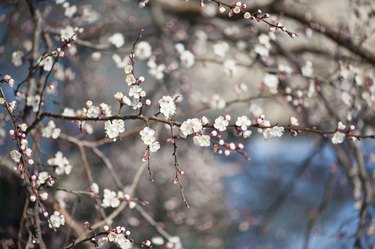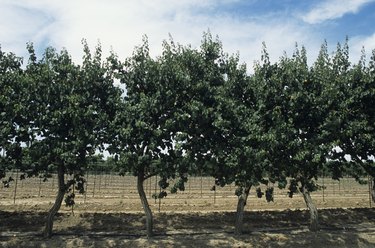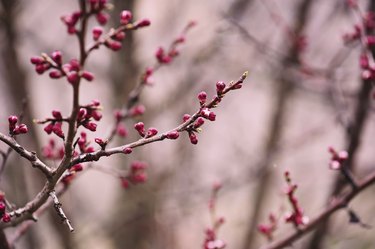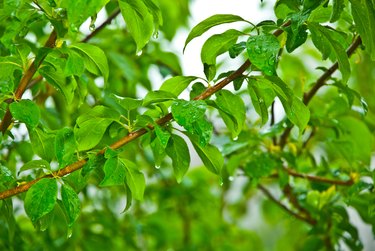
Native to Central Asia, apricot (Prunus armeniaca) has been cultivated for millennia. It's one of the more challenging stone fruit trees to grow in home gardens. Apricot flowers early, often in February or March, subjecting buds and flowers to late killing frosts. Apricot needs hot summer temperatures to ripen fruit, and between 600 and 900 hours of winter chill. Different varieties of apricots allow gardeners to successfully grow them in areas ordinarily marginal or inappropriate for the parent species.
Late-Blooming Varieties
Video of the Day

Where winters are cold but summers are warm enough for apricot fruit ripening, gardeners can combine varieties that are later-blooming with cultural strategies such as choosing the warmest available planting site, providing windbreaks or espaliering apricot against a wall. "Harcot" apricot is a late-blooming variety that needs 700 hours of winter chill. It grows 15 to 25 feet tall in U.S. Department of Agriculture plant hardiness zones 5 through 7. Other varieties suitable for cold winter areas and hardy to USDA zones 4 through 7 include "Hargrand," "Harlayne," "Harogem," "Harojoy" and "Harostar."
Video of the Day
Early-, Medium- or Late-Ripening Varieties

Extend the time you can enjoy your apricot harvest by planting trees that ripen their fruit at different times. "Goldkist," which grows in USDA zones 7 through 9, ripens early. Midseason fruit trees include "Blenheim," hardy in USDA zones 5 through 9, and "Tilton," which grows in USDA zones 4 through 9. For late-season harvest, choose "Autumn Royal" or "Moorpark," both growing in USDA zones 5 through 9.
Low-Chill Varieties

Winter chill hours indicates the number of hours the tree spends below between 32 degrees Fahrenheit and 45 degrees F. Some methods calculate a chill hour as any time temperatures fall below 45 degrees F. Apricot varieties with low chill requirements allow gardeners in mild winter areas to successfully harvest the fruit. "Gold Kist" requires about 150 to 200 chill hours and bears early in the season, making it suitable for desert areas where hot summer temperatures negatively affect fruit quality. "Gold Kist" grows in USDA zones 7 through 9. "Autumn Royal" and "Golden Amber," both growing in USDA zones 5 through 9, need between 250 and 400 chill hours.
Short Apricot Varieties

Standard-sized apricot trees normally grow 20 to 30 feet tall. If you have limited space, consider adding semi-dwarf or dwarf apricot trees. Semi-dwarf apricots trees are created by grafting standard-sized apricots such as "Blenhein" and "Harcot" onto a dwarfing rootstock, which reduces the height of the tree to about 12 to 18 feet tall. An apricot bred to be small, "Stark Golden Glo" (Prunus armeniaca "Zaiglo"), which grows in USDA zones 5 through 8, is 4 to 6 feet tall and 2 to 4 feet wide. This dwarf tree bears full-size apricots.
- California Rare Fruit Growers: Fruit Facts: Apricot
- Oregon CropMAP: Oregon Tree Fruits and Nuts
- University of Illinois Extension: Hortanswers: Apricots Prunus Armeniaca L.
- Monrovia: Harcot Apricot
- University of California Extension: Marin Master Gardeners: Growing In Your Garden Now - Apricots
- Bay Laurel Nursery: Rootstock Descriptions
- Missouri Botanical Garden: Prunus Armeniaca "Zaiglo" Stark Golden Glo